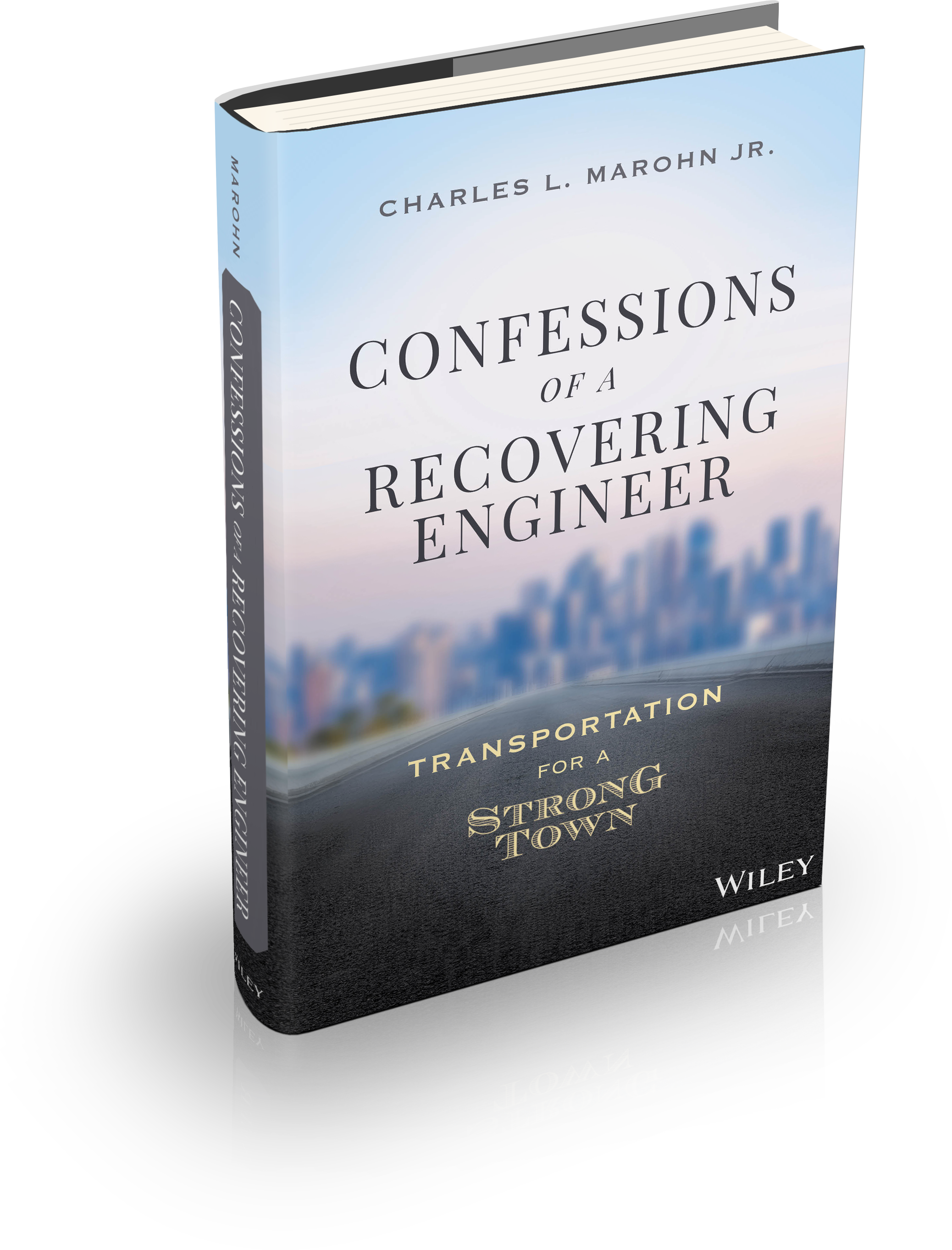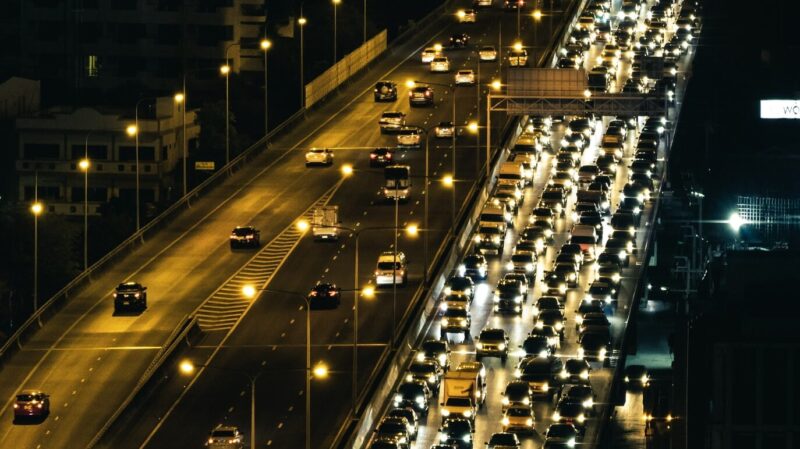“Almost all of our transportation investments go to support commuters and, by extension, the proliferation of the development pattern that accompanies the commuting lifestyle.”
This article was written by Charles Marohn and originally published by Strong Towns.
I wrote these words last week for an article on a light rail project here in Minnesota (“The Real Reason We Keep Getting Distracted by Transit Boondoggles”), an article in which I forcefully rejected the consensus idea that public spending on transportation should primarily focus on accommodating commuters.
Of course, the question that naturally follows—the one I didn’t answer—is this: If we’re not focusing our transportation investments on making commuting easier, what do we do with all these commuters?
And, by extension, what do we do with all of the accessories that come with commuting culture, from the gas stations and big box stores to the mega-school campuses and regional parks?
If we’re not spending exorbitant amounts of money each year expanding our ability to accommodate commuting patterns, aren’t we going to be overwhelmed with traffic congestion and won’t that be a disaster?
Well, it really depends on what “disaster” looks like to you. When I step back and look at where we are already, all I see is disaster, beginning with how we deal with congestion.
Even if We Want a War on Congestion, We Don’t Have the Money
I participated in a forum put on by the Washington Post where speaker after speaker (including thought leaders like the now-President Joe Biden) talked about traffic congestion as the primary problem we need to address with our transportation investments.
There are essentially three ways to address congestion. We can: (1) build more capacity, (2) use existing capacity more efficiently, or (3) reduce demand for trips, especially during congested periods.
The first of these—build more capacity—should be a non-starter. Quite frankly, I’m perplexed as to why it isn’t completely laughable to everyone and, even more so, why it’s a strategy that has any credibility at all.

TRANSPORTATION IS GETTING WORSE AND COSTING MORE.
The good news is, it is possible to build a transportation system that makes you and your community safer and more prosperous. Our book, Confessions of a Recovering Engineer will show you how.
Last year, the Biden administration released the American Jobs Plan, the president’s plan to make a generational investment in infrastructure. The one talking point for this plan that generated widespread consensus was that it was a huge number. Team Blue touted the bold commitment of a large price tag while Team Red attacked the recklessness and prolificacy of that same spending. Whatever your perspective, everyone thought it was a serious dollar amount.
The American Jobs Plan identified 173,000 total miles of highways and major roads already in poor condition. Over the next decade, this plan, with its unprecedented amount of spending, proposed to “modernize” 20,000 of those miles. That is just 12% of the roads currently in poor condition. Over the next decade.
Let’s be clear: Over the next decade, more than 20,000 miles of existing roads will go from “good” to “poor” condition, more than this unprecedented commitment to spending by the administration proposes to fix. In other words, the largest infrastructure investment in our lifetime doesn’t keep up with the rate of decline of the roads we’ve already built.
The same is true of the nation’s bridges. The American Jobs Plan identified 45,000 bridges in poor condition. It proposed to repair 10,000 of them over the next decade. Each one of these infrastructure investments requires some type of local match, ensuring that whatever theoretical capacity there might be to maintain just our existing infrastructure is tapped in service of this plan.
Under the president’s plan, our roads will crumble and our bridges fall apart faster than we can fix them. Yet, the smaller plan that was ultimately approved, the bipartisan compromise, does even less.
If we’re not going to have a credible plan for maintaining our existing transportation infrastructure (and, rest assured, there is no credible plan), then how do we even ponder a strategy that adds capacity to the existing system?
Illinois, one of the most insolvent states, carries a transportation backlog in the tens of billions of dollars, but that doesn’t stop their policy leaders from planning for additional expansion to, you guessed it, address congestion.
“Expanding the system is a real possibility,” said one policy expert. The internal dissonance with reality necessary to make such a statement is stunning. Any public policy leader promoting expansion of our transportation systems should not be taken seriously.
We Need our Public Investments to be More Productive
If we can’t expand, and are actually likely to experience system decline or contraction, then what about making better use of our existing transportation investments? This is a great idea in theory, and in practice it might help at the margins, but it won’t get us anywhere close to where we need to be.
The classic case of squeezing more congestion-fighting capacity out of our existing system is the installation of ramp meters, a method of privileging the convenience of distant commuters over that of anyone living closer to the center of the city. By forcing core residents to wait at meters while commuters speed by on the highway, traffic engineers can theoretically accommodate more vehicles on the same roadway during peak hours.
That relationship will remain true until the dynamic nature of traffic reveals itself. Humans respond to having additional capacity by doing human things, like driving more and choosing a larger house, further away, because the commute is not so bad anymore. When enough humans act like humans, the roadway fills back up, congestion returns—likely even more intensely—and whatever efficiency gains were made are given back.
Our fetish with automated vehicles comes from the same mindset. Just imagine if computers could drive our cars and we could cram more cars into the same space because we wouldn’t need all that distance between vehicles! Listening to Peter Norton will be a wakeup call to those of you who think that automated vehicles are about to save us, but simple geometry once again sets a limit for efficiency no computer can overcome.
Transit expansions, especially large and very expensive projects, have the potential to dramatically increase efficiency on the corridor in which people are being transported, but commuter development patterns are diffuse by nature. Yes, we can create transit-oriented development along new or refreshed transit routes, but once again, we’re running into the money challenges, not to mention a cultural resistance to change. In most places, especially those where traffic congestion during commutes is the problem, there’s not enough pre-existing transit there to make it work.
And that’s really the core problem commuting culture creates, a challenge that money spent fighting congestion only makes worse: the diffuse development pattern generates more public costs than it builds private wealth. These are low productivity environments, a financial imbalance that no transportation investment will overcome.
Most of our audience is aware of the work of Urban3, particularly the insightful productivity mapping approach they have pioneered. They have demonstrated over and over in cities around the world that financial productivity is the key to local creation, and there is nothing less productive than auto-oriented development on the edge of a city. When we spread everyone out, we drive up costs and dilute the tax base, creating long-term fiscal insolvency for local governments and the communities they serve.

(Source: Urban3.)
In Confessions of a Recovering Engineer, I wrote about the Hydrology 101 problem, the compounding impacts of small changes in the development pattern on the periphery. Without another way to respond to the stress of traffic congestion, we will always induce more traffic demand than our efficiency gains can provide.
Congestion is Our Ally in Building Bottom-Up Wealth and Capacity
We don’t have the money to fight congestion—we don’t even have the money to maintain the roadways we’ve already built—and since we can’t change the geometric limitations of our roadway, not matter the technology, we’re left with only one viable response: We have to reduce the demand for trips.
Let me state that in a more positive way: We need to provide alternatives that allow people to opt out of an automobile trip. We need to create options.
More specifically, we need private individuals and businesses to create options while the community avoids additional unfunded burdens. We need to improve our communities’ financial productivity.
What do options look like? They look like the ability to walk to the corner grocer instead of driving to the big box store. They look like the ability to bike to a neighborhood school instead of getting dropped off at the mega campus on the outskirts of town. They look like the ability to work from home and have your shopping delivered to you (and your neighbors) instead of each of you taking a trip on your own.
None of this is scary, and a lot of it is happening regardless, but we can lean into it, and support it, instead of undermining it by spending money we don’t have fighting congestion we can’t rid ourselves of.
In fact, congestion drives the demand for options. The more stifling the levels of congestion one must pass through to get milk at the big box grocer, the more someone will value a corner grocer that can provide the same product. This is true over the many dimensions of our lives, and that truth can utterly transform our economy, making our neighborhoods not only more productive but more responsive to our needs.
We have spent trillions making it easy to drive everywhere, so much so that we made it difficult to walk anywhere. We maxed out that model decades ago and have long been into diminishing returns. It’s time to start investing in the other direction.
It’s time to start transforming our neighborhoods into Strong Towns.





